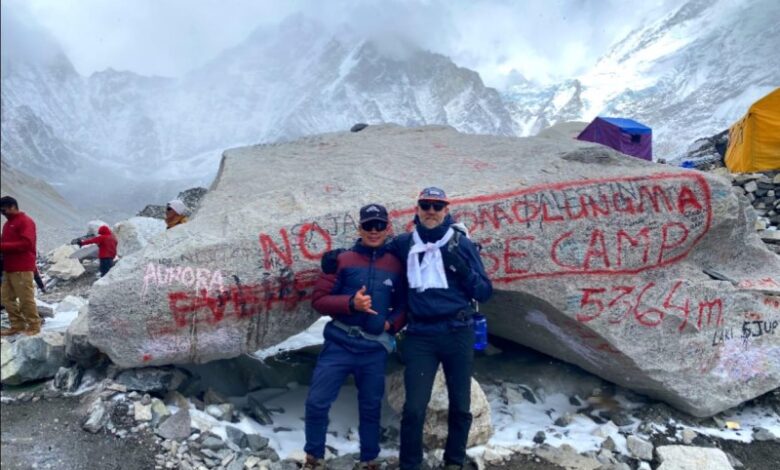Everest Base Camp Heli Return vs. Full Trek: Which is Better?

Imagine standing at Everest Base Camp, the wind brushing your face as you gaze up at the towering peak of the world’s highest mountain. You’ve made it. But now comes the decision: do you trek all the way back or soar above the Himalayas in a helicopter?
This choice between a full Everest Base Camp trek and a heli return isn’t just about convenience—it’s about how you want to experience this iconic journey. Some crave the accomplishment of a round-trip hike, pushing physical limits and soaking in every footstep. Others opt for the thrill and time-saving luxury of a helicopter return, swapping rocky trails for aerial views.
For many trekkers, this decision brings confusion. Is one option safer? More scenic? Worth the extra cost? This blog unpacks the key differences between the Everest Base Camp heli return vs. full trek so you can choose what aligns with your goals, time, and budget. Whether you’re dreaming of epic adventure or balancing ambition with comfort, you’ll find clarity here—along with insights from seasoned trekkers and local experts who know these trails like the backs of their hands.
What Are Your Everest Base Camp Trek Options?
You have two main ways to complete the Everest Base Camp trek:
1. Full Trek (Round Trip)
This is the classic option. You hike both to and from Everest Base Camp.
- Total duration: 12 to 14 days.
- Start and end in Lukla.
- Pass through iconic villages like Namche Bazaar, Tengboche, and Dingboche twice.
Pros:
- Full acclimatization through gradual ascent and descent.
- More time to experience Sherpa culture and Himalayan landscapes.
- Cost-effective compared to flying.
Expert Insight: Many guides recommend the full trek for proper acclimatization. Descending gradually reduces the risk of altitude sickness. Sherpas often say, “You don’t just go up the mountain, you come back wiser.”
2. Everest Base Camp Trek with Helicopter Return
This hybrid option combines trekking up to Base Camp with a helicopter flight back to Lukla or Kathmandu.
- Total duration: 8 to 10 days.
- Trek up to Gorakshep or Kala Patthar, then fly out.
- Enjoy aerial views of Everest and surrounding peaks.
Pros:
- Saves time and physical effort on the return journey.
- Offers a luxurious and scenic finish to your trek.
- Ideal for trekkers short on time or struggling with descent.
Real-World Tip: Weather affects helicopter schedules. Mornings are best for flights—clear skies and stable winds. Always have a buffer day in case of delays.
Both Everest Base Camp trek options offer unforgettable experiences. Choosing the right one depends on your fitness level, schedule, and personal travel goals.
Comparing the Two: Which Is Better for You?
Choosing between an Everest Base Camp heli return vs. full trek depends on your priorities.
Let’s break it down by key factors:
1. Time Available
- Full trek: Needs 12–14 days. Ideal if you’re not on a tight schedule.
- Heli return: Completes in 8–10 days. Great for busy travelers.
Tip: Add at least two buffer days to either plan in case of flight delays in or out of Lukla.
2. Physical Challenge
- Full trek is physically demanding, especially the descent. It tests endurance and knee strength.
- Heli return avoids the long descent, saving your joints from added stress.
Insight: Many trekkers underestimate the descent. It’s where most blisters and fatigue set in.
3. Acclimatization and Altitude Safety
- Full trek allows gradual acclimatization both up and down.
- Heli return skips the natural descent, which may affect your adjustment.
Expert Note: The descent helps your body adjust post-summit. Skipping it can increase the risk of headaches or fatigue.
4. Budget
- Full trek: Generally more budget-friendly.
- Heli return: Adds $800–$1200 depending on weather and group size.
Fact: Helicopter costs vary based on season, demand, and whether it’s a private or shared flight.
5. Scenic and Cultural Experience
- Full trek lets you absorb the landscape from all angles and revisit friendly teahouses.
- Heli return delivers unmatched aerial views in a matter of minutes.
Local Perspective: Sherpas say the trail teaches patience—you see more when you walk both ways.
Both options suit different needs. If you value immersive trekking and savings, choose the full trek. If comfort, time, and spectacular views matter most, go for the heli return.
Who Should Choose the Full Trek?
The full Everest Base Camp trek is best for those who want a deep, immersive mountain experience.
Ideal for:
- Trekkers with a flexible schedule (12–14 days plus buffer days).
- Adventure seekers who enjoy physical challenges.
- Budget-conscious travelers looking to avoid high heli costs.
- Nature lovers who want to see the Himalayas from every angle.
Why It’s Worth It
- Complete Acclimatization: Descending gradually is scientifically proven to help your body recover from high altitude.
- Deeper Cultural Connection: You revisit Sherpa villages, allowing for more authentic local interactions.
- Mental Endurance: Completing the round trip is a test of mental grit and resilience.
Sherpa Wisdom: “The mountain humbles you when you return the same way you came.”
Real-World Insights
Many guides recommend the full trek for first-timers. It teaches pacing, patience, and respect for the altitude.
You’ll also meet more trekkers on the way down. These connections often create lasting memories.
Teahouse owners along the return route often remember you, offering a warm welcome and extra dal bhat.
- Also Read: Best Treks Near Kathmandu
Budget Benefit
Trekking both ways means fewer logistics and no extra helicopter costs. Great for solo trekkers or small groups.
Final Thought
If you want to absorb every moment, grow through challenges, and save on cost, the full trek is the better choice.
You’ll return stronger—physically and mentally—with a richer story to tell.
Who Should Choose the Helicopter Return?
A helicopter return from Everest Base Camp is perfect for trekkers who value speed, comfort, and unforgettable views.
Best for:
- Travelers short on time but still want to reach Base Camp.
- Trekkers who prefer a lighter physical challenge.
- Photographers and videographers seeking aerial footage.
- Older or less mobile adventurers concerned about downhill strain.
Why It Makes Sense
- Time Saver: Shaves off 3–4 days. You can enjoy the Himalayas without using up all your vacation time.
- Physical Relief: Avoids the tough, knee-straining descent.
- Bucket-List Views: See Everest, Lhotse, and Ama Dablam from above. It’s a once-in-a-lifetime photo opportunity.
Trek Leader Insight: Many older trekkers or those recovering from illness choose heli return to protect their knees and lungs.
Real-World Considerations
Weather can delay flights. Helicopters usually fly early morning for the clearest skies.
Always plan a buffer day in case of schedule changes.
Altitude symptoms can linger if you descend too quickly. Drink plenty of water and rest even after your flight.
Budget vs. Comfort
- Helicopter return adds $800–$1200 to your trek budget.
- Worth it if you prioritize convenience, comfort, or have limited days.
Sherpa Tip: If you’re feeling exhausted at Base Camp or Gorakshep, a heli ride isn’t luxury—it’s smart recovery.
Final Thought
The heli return option suits anyone who wants a quicker, more relaxed exit from the mountains.
You’ll get home sooner—with epic aerial memories and less fatigue on your body.
Safety Considerations and Weather Factors
High-altitude trekking and helicopter flights both come with risks. Knowing how to manage them makes your EBC trek safer.
Altitude and Acclimatization
- AMS (Acute Mountain Sickness) can strike anyone, regardless of age or fitness.
- Symptoms include headache, nausea, dizziness, and shortness of breath.
Expert Tip: Follow the “climb high, sleep low” principle and include rest days.
- Full trekkers benefit from a gradual descent, helping the body recover from high elevation.
- Heli return skips this descent, which can lead to lingering altitude symptoms even after landing.
Helicopter Flight Risks
- Flights are subject to sudden weather changes in the Himalayas.
- Wind, cloud cover, and visibility can delay or cancel flights at short notice.
Real-World Insight: Pilots prioritize safety. If conditions aren’t perfect, flights are grounded.
- Morning flights are more reliable—plan accordingly.
- Always keep a flexible itinerary with buffer days.
Insurance Essentials
- Not all travel insurance covers high-altitude trekking or helicopter evacuation.
- Choose a policy that includes coverage up to 6,000 meters.
Pro Tip: Check if your insurance covers both medical evacuation and trip interruption.
Weather Conditions to Watch
- Best months: Pre-monsoon (March–May) and post-monsoon (late September–November).
- Avoid monsoon season (June–August) and deep winter (January–February) for safety.
Sherpa Knowledge: Clear skies and stable winds usually occur between 6 a.m. and 9 a.m.
Final Reminder
Whether you’re trekking or flying, safety depends on preparation, flexibility, and respect for the mountains.
Never rush decisions at altitude. Listen to your body and the advice of experienced guides.
Conclusion
There’s no one-size-fits-all answer in the Everest Base Camp heli return vs. full trek debate—just what’s right for you.
If you’re craving a slow, immersive experience and are up for the physical challenge, the full trek is incredibly rewarding. If you’re short on time or want to avoid the descent, a helicopter return offers convenience with jaw-dropping views.
Whichever path you choose, remember this: standing at Base Camp is already a major achievement.
So what kind of adventurer are you—grounded and gritty, or sky-bound and efficient?
Let us know in the comments or share this with a fellow trekker making the same decision!


